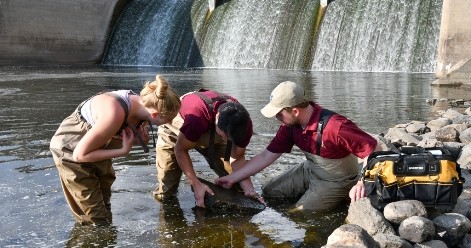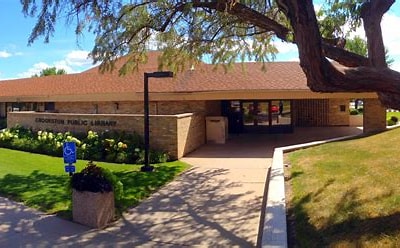It isn’t necessary to go to the ocean to find a sponge. In the sunlight dappled waters of a Minnesota stream or lake, a freshwater sponge might be thriving.
The idea of freshwater sponges living in lakes and streams in Minnesota may come as a surprise to many, but these simplest-of-all animals have been filtering the waters of the northland for millennia and their presence has often been overlooked. What makes the study of these animals significant is their possible connection to the health of freshwater ecosystems in the state.
Since spring 2016, four faculty members—two biologists and two chemists—at the University of Minnesota Crookston (UMC) have been focused on these non-moving invertebrates living at the bottom of bodies of water and what their presence might mean to Minnesota waters.
The work of UMC faculty members Karl Anderson, Anthony Schroeder, Venuopgal Mukku, and Timothy Dudley, along with a number of undergraduate students, could lead to the discovery of new species. But most important is the contribution they are making to the DNA sequencing of freshwater sponges and to a greater understanding of these simple organisms and their role in the evolutionary cycle. A more complete picture of the relationship of sponges to water quality and their presence as a bio-indicator of a healthy ecosystem could also result from the research.
Biologists Anderson and Schroeder are on the front line collecting specimens, labeling, documenting, and conducting immediate testing on site. Once they have a specimen, measuring up to an inch square along with a separate sample of the water, they record location, PH, temperature, dissolved oxygen, and conductivity readings. They also note anything else in the surroundings such as the existence of zebra mussels for example.
The last documented study on Minnesota’s freshwater sponges took place in the summer of 1970 when a University of Minnesota graduate student began collecting sponge specimens in Itasca State Park. Today, scientists using technology unavailable in the 1970s are generating new data that could reveal a great deal more about the sponges and their environment.
The samples collected are stored on ice until they are taken back to the lab usually within 24 to 36 hours. Then, the samples are separated: some for storage and archiving and others prepared for genetic analysis, using molecular biology and other modern research techniques.
The remaining material is freeze-dried to remove water. With the water removed, the resulting chemical residue is in turn studied by chemists Venuopgal Mukku and Tim Dudley who determine the makeup of the residue and what it might tell them about the habitat. They also test to see if what is filtered by the sponge is sequestered in their cells. One important potential consequence of chemical absorption by sponges is the ability of those chemicals to move up the food chain.
Background
Sponges, which belong to the phylum Porifera meaning pore bearer, obtain food from the flow of water passing through them. They grow in locations exposed to sunlight with protection from natural predators like caddisflies and crayfish.
There have been about 200 species of freshwater sponges identified worldwide and 32 of those are in North America. There is reason to believe that genetic analysis could reveal new sponge species in Minnesota along with the two previously recorded.
For undergraduates at UMC, the study is an opportunity to develop skills in biology and chemistry and to work across majors in the areas of science, communication, and others making this research an interdisciplinary effort.
Calling Citizen-Scientists
Beyond the classroom, citizen-scientists are encouraged to report locations of sponges by sending the information to umcspongersrch@umn.edu or calling 218-281-8240. There has already been significant interest and reporting by citizen-scientists across the state.
The Minnesota Department of Natural Resources has been helpful in recommending locations for sponge investigation and recreational divers have provided information on sponges in lakes where they dive, along with those who have been walking along a stream or lake and noted their presence.
Support for the project has come for Office of Academic and Student Affairs, Math, Science, and Technology Department at UMC as well as funding from Legislative-Citizen Commission on Minnesota Resources (LCCMR), and donations from Cabela’s.
Visit the Minnesota Freshwater Sponge Project website located at https://freshwatersponges.crk.umn.edu.




